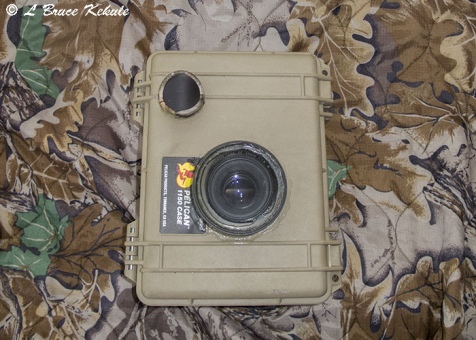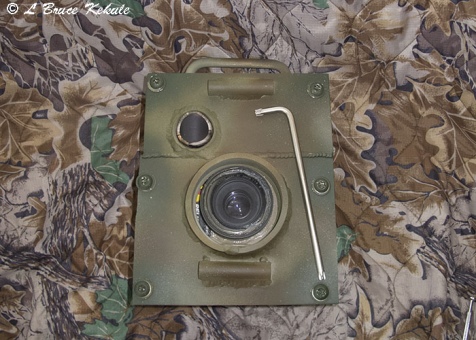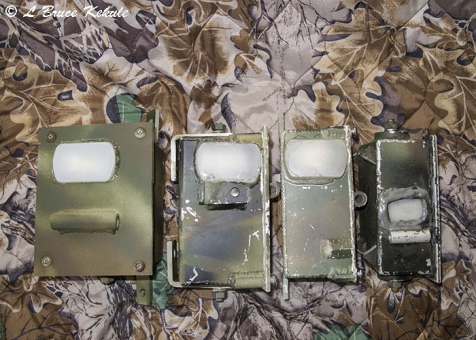A Canon 400D trail cam
A new/old Canon 400D: An easy DSLR in cost and production
Canon 400D with battery grip/Pelican 1150/Snapshot Sniper SSII board/Yongnuo wireless flash trigger plus two ‘D’ cell externals.
Back in march 2012, I built and posted my first DSLR trail cam around a Canon 400D with 18-55mm kit-lens and a Yeticam board (EOS chip) in an old recycled aluminum box I had made up for Minolta 800 si SLR film camera years ago.
I was using Yongnuo wireless flash triggers tripping three Canon 270EX flashes and it was working OK when I left it. Elephants bashed the thin-tube aluminum snorkel breaking the front glass, and then it rained. And that was that…!
Canon 400D in the box.
I then picked up a Canon 350D with the 18-55 kit-lens and got another Yeti board rebuilding the cam. The snorkel was busted again by the forest giants but it did not rain this time and I was able to get it going again with a new replacement glass (77mm UV filter) and an ‘elephant proof’ snorkel protector. This cam is presently working very close to where I camera trapped and was charged by a bull guar.
The 400D in an ‘elephant proof’ box.
I decided to buy a second-hand Canon 400D (Rebel XT-i) body only but this time went with a fixed Canon 50mm ƒ1.8 lens. I picked up a Pelican 1150 box and one of Snapshot Sniper SSII #5 boards and hooked it up with a Canon shutter release (button removed and it has a good 90-degree plug). A 77mm aluminum tube and filter is glued to the case with Goop. A Snapshot Sniper HPWA with a black Fresnel is used with the sniper board.
Canon 400D ready for the field.
The shutter release shielded wire is ground and white is shutter and red is power. The camera is set to ‘Continuous’ and the board to trail mode. I’m getting 5-6 frames per trip and can trip as many as four-five flashes at once. I have several different locations planned for this cam. With a Yongnuo 603C wireless flash trigger with two ‘D’ cell externals and everything fits nicely in the 1150.
Flashes to be used with the Canon 400D.
I have two recycled flashes (a Canon 270EX and a Nikon SB-28) that will make up the group. Another two Nikon SB-26s on ‘stand-by’ mode will also be put into service (one with four ‘C’ cells and one with four ‘D’ cells) to see how long the respective batteries will last. A special modification is made to the SB-26s to allow regular 6-volt 4-cell packs to be used. Another mod is to unhook the ribbon to the monitor after the flash has been set-up (mostly half-power). This will reduce power consumption on the SB-26s.
Nikon SB-26s: one with four ‘C’ cells and one with four ‘D’ cells.
The Canon 400D (300, 350 or 450Ds) are not that big or expensive. There is plenty of room for a pipe through and Python locking cable. It will shoot in ‘Raw’ mode that will allow some latitude in post-processing.
As usual, I have made up an elephant proof aluminum box that will be bolted to a tree with three 3”x 3/8” stainless lag bolts from inside the box plus two 10mm Python cables. The front cover is bolted to the box using six 10mm power-torque machine screws. The flashes are in aluminum boxes with 8mm power-torque machine screws bolted to trees with the same lag bolts and Python locking cables for security.
A Canon 400D with an adapter for Nikon 50mm ƒ1.4 lens.
I have another 400D that will be getting the same treatment except I have an adapter to use an old Nikon 50 ƒ1.4 manual lens. We will see what the difference is in using a plastic lens versus a glass lens. I’ll put my money on the glass out-preforming the plastic…!!
Cost of materials – cost can vary:
Canon 400D………………………………………………….. about $150 (used)
Battery pack grip……………………………………………… about $32 (new)
Canon fixed lens 50ƒ1.8 ……………………………… about $80-90 (used)
Canon Shutter release……………………………………………….. $13 (used)
Pelican 1150 case……………..……………………………………….. $30 (new)
Yonguo 603c flash triggers (a pair)……………………………… $33 (new)
Snapshot Sniper SSII board (#5 chip) & HPWA Fresnel.. $50 (new)
Total cost: about $398 plus labor and essentials (Goop, extra cam battery, drill bits, soldering tools, etc).
Hope this will give some of you camera trappers out there an incentive to build a DSLR…! The cost for some cams is not that expensive and the Canon 400D is a good choice for a first cam.








